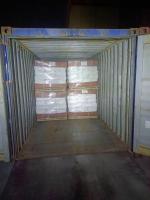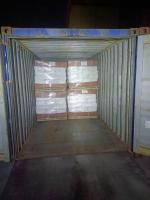The main application of Hydroxamated Polyacrylamide (HPAAM) in an aluminum factory, specifically in the alumina refining process, is to serve as an advanced flocculant for red mud settling and separation. This application is critical in the Bayer process, the predominant method used worldwide for extracting alumina (Al₂O₃) from bauxite ore.
Introduction to Hydroxamated Polyacrylamide (HPAAM)
Hydroxamated Polyacrylamide (HPAAM) is a chemically modified polyacrylamide, containing hydroxamic acid functional groups. These groups have high affinity for multivalent metal ions, particularly iron(III) and aluminum(III) oxides, which are abundant in red mud—an insoluble byproduct of bauxite digestion in caustic soda.
Due to its unique ability to bind with metal oxides and form strong coordination complexes, HPAAM is especially suitable for selective flocculation in high-pH, high-temperature environments like those found in aluminum plants.
⚙️ Background: The Bayer Process and Red Mud Formation
In the Bayer process, crushed bauxite is digested in a high-temperature, high-pH caustic soda solution, which dissolves alumina from the ore. This leaves behind an insoluble residue known as red mud, composed mainly of:
-
Iron oxides (Fe₂O₃, Fe₃O₄)
-
Aluminum oxides (Al₂O₃·xH₂O)
-
Silica (SiO₂)
-
Titanium dioxide (TiO₂)
-
Unreacted bauxite minerals
Before the dissolved alumina can be recovered through precipitation, it is essential to separate red mud from the caustic liquor. This is where flocculants like HPAAM are used.
Main Application: Red Mud Flocculation
➤ How HPAAM Works in Red Mud Settling
HPAAM is dosed into primary settlers or thickeners, where it performs the following critical functions:
-
Selective Adsorption on Red Mud Particles
The hydroxamic acid groups in HPAAM selectively chelate metal ions (especially Fe³⁺ and Al³⁺) on the surface of red mud particles. This forms a strong chemical bond, enhancing particle capture. -
Polymer Bridging and Floc Formation
HPAAM, being a high molecular weight polymer, acts as a bridge between multiple particles, causing them to aggregate into large, dense flocs that settle quickly. -
Rapid Settling and Clarification
The flocs settle to the bottom of the settler, allowing the clear sodium aluminate liquor to overflow and be sent to precipitation.
Key Benefits of Using HPAAM in Aluminum Plants
1. Faster Red Mud Settling
HPAAM enables red mud particles to settle more quickly and compactly, which increases the efficiency of primary thickeners and reduces residence time.
2. Improved Overflow Clarity
The flocculation process facilitated by HPAAM results in a significant reduction of suspended solids in the overflow, leading to clearer liquor and improved downstream processes.
3. Higher Underflow Solids Content
HPAAM helps produce a denser red mud underflow, which reduces the volume of slurry needing further treatment or disposal.
4. Reduced Caustic Soda Loss
With better solid-liquid separation, less caustic liquor is trapped in red mud, enhancing caustic soda recovery and reducing operating costs.
5. Enhanced Washer Circuit Performance
In the multi-stage counter-current decantation (CCD) systems used to wash red mud, HPAAM maintains floc integrity, preventing re-suspension and improving washing efficiency.
6. Lower Flocculant Dosage
Compared to conventional anionic polyacrylamides, HPAAM achieves better performance at lower dosages, offering economic and environmental advantages.
Technical Characteristics of HPAAM
| Property | Details |
|---|---|
| Functional group | Hydroxamic acid (-CONHOH) |
| Polymer backbone | Polyacrylamide (nonionic or weakly anionic) |
| Charge behavior | Typically nonionic to weak anionic |
| Metal selectivity | Strong affinity for Fe³⁺, Al³⁺ oxides |
| Operating pH range | Effective in high-pH environments (pH > 13) |
| Temperature resistance | Stable up to 95–100°C (typical in Bayer process) |
Application Points in the Aluminum Factory
HPAAM is primarily used in the following areas:
1. Primary Settlers
Initial separation of red mud from sodium aluminate liquor occurs here. HPAAM ensures fast settling and clear overflow.
2. Secondary Thickeners
Sometimes used to polish the overflow from primary settlers. HPAAM can improve performance here when needed.
3. Red Mud Washers (CCDs)
Helps maintain floc strength during washing, minimizing solids loss in overflow and improving caustic recovery.
4. Red Mud Disposal and Filtration
In some plants, pre-thickening or flocculation of red mud is required before disposal or filtration. HPAAM assists in achieving optimal rheology.
Environmental & Economic Considerations
HPAAM offers several environmental and cost-saving advantages in aluminum plants:
-
Reduced polymer usage due to selective action
-
Lower chemical residue in waste streams
-
Minimized caustic loss, reducing the need for fresh NaOH
-
Improved plant throughput and operational stability
Summary
| Parameter | Description |
|---|---|
| Main Use | Flocculant for red mud settling in Bayer process |
| Key Mechanism | Metal oxide binding via hydroxamic acid groups + polymer bridging |
| Core Benefits | Faster settling, clearer overflow, reduced caustic loss |
| Best Use Stage | Primary and secondary thickeners, washer circuits |
| Operating Conditions | High pH (13–14), High temp (80–100°C) |
| Industry Advantage | Efficient, selective, and cost-effective flocculation |
In conclusion, the main application of Hydroxamated Polyacrylamide (HPAAM) in aluminum plants is as a selective and highly efficient red mud flocculant. Its ability to bind metal oxides and form strong, shear-resistant flocs makes it essential for optimizing the solid-liquid separation stage in alumina refineries. This leads to improved process efficiency, reduced chemical loss, and enhanced environmental performance, positioning HPAAM as a superior solution in modern aluminum manufacturing operations.




115_small.jpg)

